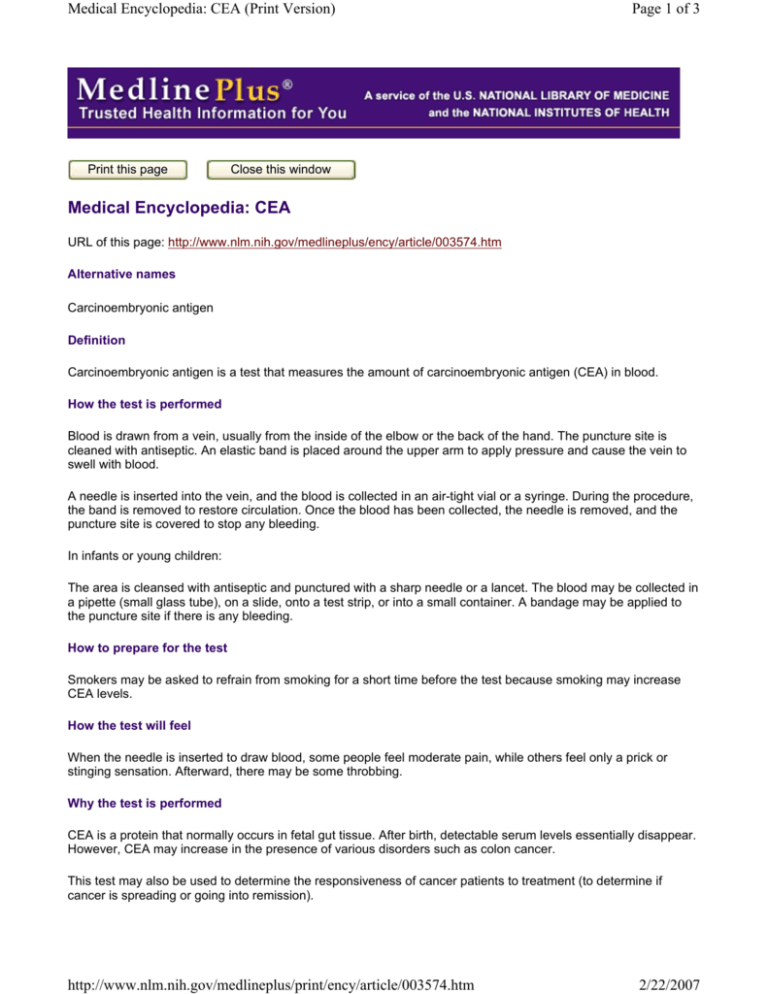Medical Encyclopedia: CEA
advertisement

Medical Encyclopedia: CEA (Print Version) Print this page Page 1 of 3 Close this window Medical Encyclopedia: CEA URL of this page: http://www.nlm.nih.gov/medlineplus/ency/article/003574.htm Alternative names Carcinoembryonic antigen Definition Carcinoembryonic antigen is a test that measures the amount of carcinoembryonic antigen (CEA) in blood. How the test is performed Blood is drawn from a vein, usually from the inside of the elbow or the back of the hand. The puncture site is cleaned with antiseptic. An elastic band is placed around the upper arm to apply pressure and cause the vein to swell with blood. A needle is inserted into the vein, and the blood is collected in an air-tight vial or a syringe. During the procedure, the band is removed to restore circulation. Once the blood has been collected, the needle is removed, and the puncture site is covered to stop any bleeding. In infants or young children: The area is cleansed with antiseptic and punctured with a sharp needle or a lancet. The blood may be collected in a pipette (small glass tube), on a slide, onto a test strip, or into a small container. A bandage may be applied to the puncture site if there is any bleeding. How to prepare for the test Smokers may be asked to refrain from smoking for a short time before the test because smoking may increase CEA levels. How the test will feel When the needle is inserted to draw blood, some people feel moderate pain, while others feel only a prick or stinging sensation. Afterward, there may be some throbbing. Why the test is performed CEA is a protein that normally occurs in fetal gut tissue. After birth, detectable serum levels essentially disappear. However, CEA may increase in the presence of various disorders such as colon cancer. This test may also be used to determine the responsiveness of cancer patients to treatment (to determine if cancer is spreading or going into remission). http://www.nlm.nih.gov/medlineplus/print/ency/article/003574.htm 2/22/2007 Medical Encyclopedia: CEA (Print Version) Page 2 of 3 Normal Values The normal range is 0 to 2.5 mcg/L ( less than 3 ng/mL). Normal value ranges may vary slightly among different laboratories. Note: mcg/L = micrograms per liter; ng/mL = nanograms per milliliter What abnormal results mean Greater-than-normal levels may indicate: z z z z z z z z z z z z Colon cancer Breast cancer Lung cancer Pancreatic cancer Thyroid cancer Genitourinary carcinomas Inflammatory gastrointestinal diseases (for example, ulcerative colitis, diverticulitis, cholecystitis, pancreatitis) Cirrhosis Other liver disease Peptic ulcer Heavy smoking Pulmonary infections What the risks are z z z z z Excessive bleeding Fainting or feeling lightheaded Hematoma (blood accumulating under the skin) Infection (a slight risk any time the skin is broken) Multiple punctures to locate veins Special considerations This test is most useful to follow response to treatment in patients with known cancer. Abnormal levels can be found in patients without cancer. Veins and arteries vary in size from one patient to another and from one side of the body to the other. Obtaining a blood sample may be more difficult from some people than from others. Update Date: 1/26/2005 Updated by: Rita Nanda, MD., Department of Hematology/Oncology, University of Chicago Medical Center, Chicago, IL. Review provided by VeriMed Healthcare Network. A.D.A.M., Inc. is accredited by URAC, also known as the American Accreditation HealthCare Commission (www.urac.org). URAC's accreditation program is the first of its kind, requiring compliance with 53 standards of quality and accountability, verified by independent audit. A.D.A.M. is among the first to achieve this important distinction for online health information and services. Learn more about A.D.A.M.'s editorial process. A.D.A.M. is also a founding member of Hi-Ethics (www.hiethics.com) and subscribes to the principles of the Health on the Net Foundation (www.hon.ch). The information provided should not be used during any medical emergency or for the diagnosis or treatment of any medical condition. A licensed physician should be consulted for diagnosis and treatment of any and all medical conditions. Call 911 for all medical emergencies. Adam makes no representation or warranty regarding the accuracy, reliability, completeness, currentness, or timeliness of the content, text or graphics. Links to other sites are provided for information only -- they do not constitute endorsements of those other sites. Copyright 2005, http://www.nlm.nih.gov/medlineplus/print/ency/article/003574.htm 2/22/2007 Medical Encyclopedia: CEA (Print Version) Page 3 of 3 A.D.A.M., Inc. Any duplication or distribution of the information contained herein is strictly prohibited. http://www.nlm.nih.gov/medlineplus/print/ency/article/003574.htm 2/22/2007











